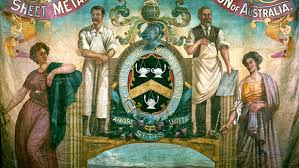Ok this is part two about banners, in Australia banners became a
feature of union processions from around the mid 1850’s. They would be made of
silk or canvas and trimmed with gold fringe or braid, they varied from the
simple to the far from simple, as in fancy. Either the original or a copy of
the Melbourne Eight-Hour Banner is I believe on display at the National Museum
of Australia but I maybe wrong.
The main source of traditional banner imagery were classical
mythology, biblical stories, heraldic devices and freemasons ritual and symbolism.
Most banners showed a masculine figure hard at work giving a man his dignity.
Women were rarely shown but there was a plethora of lightly clad goddess like
figures to show the ideals of truth and wisdom.
As well as showing the dignity of labour and skills of working
people, they also showed the new technology and pride in the latest tools and
such.
From around 1857 Australian symbols began to appear such things
as the rising sun, the southern cross later other symbols including Australian
places, wildflowers, and native animals.
Over the years problem of weathering by wind and rain resulting
in repainting and retrimming of banners but thankfully many of these old
banners can still be seen in collections around the country.
In the 1890’s despite unemployment troubles, the demise of some
unions and the problems of some unions not even being able to afford a horse
and cart to move the banners, the processions kept up.
Whereas the early marches can be seen as rites of social
integration those of the late 1890’s often became a form of social protest. In
1891 the procession in Melbourne had 52 trades and as many banners, they
marched to the sound of 20 brass bands.
More next week.







The old banners are very interesting Jo-Anne.
ReplyDeleteYes they are
DeleteThe Melbourne Eight-Hour Banner is impressively beautiful.
ReplyDeleteYes it is
DeleteCan you just imagine seeing those banners in person??
ReplyDeleteIt would wonderful
Delete